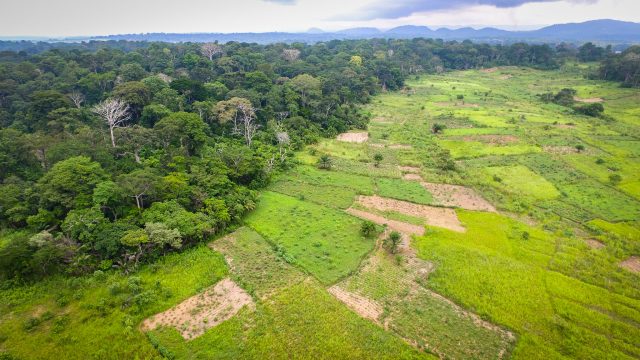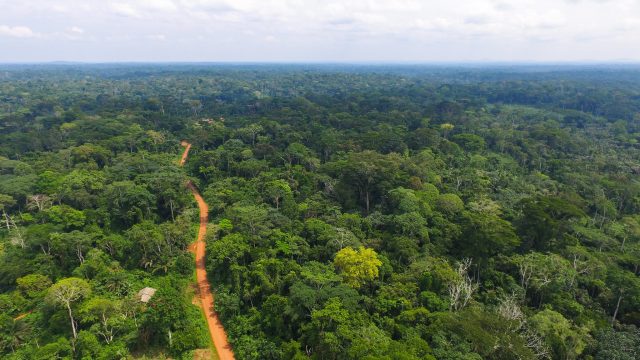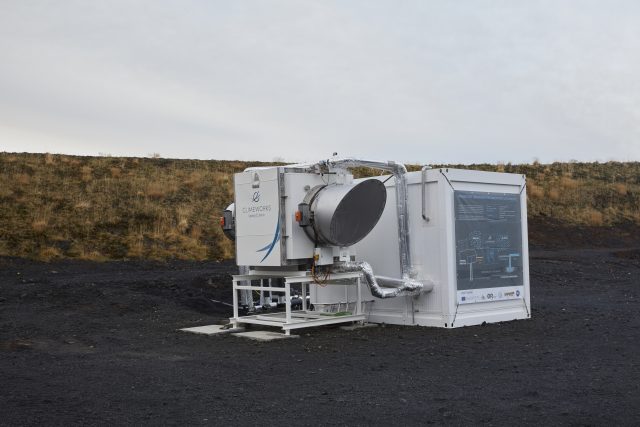
In the Middle Ages, the Catholic Church offered indulgences, letting people exchange donations for slips of paper that promised reduced time in purgatory after their death. Less controversially, today someone who over-indulges in the office tea supply might feel obliged to pay for a replacement box. Do carbon offsets more closely resemble the former or the latter?
There are many reasons why you might seek to offset part of your carbon footprint, whether it’s to assuage a general feeling of guilt for your lifestyle, to precisely cover the estimated emissions of a flight, or just to do something beneficial for the environment. Regardless of motivation, all these efforts are predicated on the belief that the money you paid truly will result in the removal of the promised amount of CO2 from the atmosphere. Otherwise, you’re paying for a lie—or at least getting a smaller box of tea than you ordered.
Finding out whether you've been lied to is genuinely difficult. Here’s what you need to know.
Downshifting the carbon cycle
Carbon dioxide in the atmosphere is part of a bio-geo-chemical dance called the carbon cycle. Carbon regularly changes form and area code, cycling among the atmosphere, oceans, ecosystems, and even bedrock. Plants take carbon atoms from CO2 in the air to grow. Herbivores consume plants and exhale the carbon as CO2 again. Weathering rocks pull CO2 out of the air. Volcanoes release it into the atmosphere. These are just some of many exchanges in the carbon cycle.
Before the Industrial Revolution, these flows were in balance, maintaining a stable concentration of CO2 in the atmosphere. But then we discovered fossil fuels and ways of lighting them on fire for fun and profit. This increasingly took carbon that had spent many millions of years locked up deep underground and liberated it into the atmosphere. Some of that carbon (a little over half, actually) was taken up by the oceans and land ecosystems. But the rest accumulated in the atmosphere, pushing greenhouse gas concentrations higher and higher.
-
This is the best estimate of current carbon cycle flows, in billions of tons of CO2 per year.,
-
This is about how much CO2 we've emitted since 1850, minus the amount taken up by oceans and land ecosystems.
To stop the rise in this greenhouse gas, our net total emissions of CO2 must reach zero. It’s that simple. We can get there in part by eliminating the emissions caused by some of our activities. But we'll probably also have to compensate for ongoing emissions to reach net zero.
Some carbon offsets projects help with this goal by preventing emissions that would otherwise have occurred. Others promise to preserve something that in carbon cycle terms is known as a “sink”—a durable form of carbon like forests or even mineralized carbonate in the ground. These offsets aren’t always identical to prevented emissions, as they can have climate effects separate from carbon. Forests, for example, can be darker than their surroundings, so their expansion results in a local warming effect as more sunlight is absorbed. But reforestation also comes with the potential to provide other ecosystem services like animal habitats. So there are a lot of factors beyond carbon to consider.
Make like a tree and leaf
Planting trees is a tantalizingly simple response to climate change. (For evidence, see: knee-jerk Internet comments.) But our capacity to store carbon this way is finite. We could undo the emissions caused by past deforestation, but we can never plant enough to cover rampant fossil fuel use. But, even if you accept that limitation, a lot can go wrong after your seedlings get tucked into the dirt.
Assuming that you find a program you can trust to actually plant the promised trees, many things will influence their carbon cycle impact over time. The first is the way that species of tree grows. Some grow quickly, accumulating a lot of carbon per acre over the first decade or so, which provides immediate help to our carbon emissions balance sheet. But fast growing trees are typically less dense than slower-growing species, so the ultimate amount of carbon stored per acre is lower.
Faster-growing species also tend to be shorter-lived. If trees in this plantation are being managed for harvesting, end-of-life will happen sooner. Then where does the carbon go? Some could be turned into lumber, at which point its value as a carbon sink depends on how long the things built with that lumber last. The leftover plant material decays or burns, releasing carbon back into the atmosphere, which ends its time as a sink,
Even if the planted trees aren’t ever harvested, their carbon could be liberated in other ways. Old trees die and rot, of course. Bug infestations can rip through the forests, killing trees en masse. Wildfires can do the same. Some risks like these are increasing due to climate change, meaning that forest carbon storage is becoming less and less safe over time in many regions.
Not just storage
Apart from questions about the limited lifetime of carbon storage, there are ecological and social impacts to consider. A plantation composed entirely of a single species won’t provide the same ecological benefits as a diverse forest ecosystem. And, if you’re not careful, you can even run the risk of planting an invasive species.
The connection between local people and a reforestation project can make or break its long-term fate. It’s easy to imagine how the human community in the area could benefit from a good planting project, but it’s also possible that it pushes them off of their land. They could end up protecting it or clearing it, depending on the situation.
All these details really matter. A successful project requires the right trees in the right place, with a mechanism for ongoing preservation, which will require work with local communities. Otherwise, “we planted x trees for you” might not mean what it says.
Maintenance
Many forest-based offsets don't involve planting trees, but focus on conserving existing forests. There are many good reasons to focus on this. Deforestation remains a significant source of greenhouse gas emissions, for one, so preservation will prevent that. And whereas new plantings might come up short in the habitat and ecosystem services department, this isn't an issue for established, diverse forests, which already provide those things.

There are downsides, though. A forest conservation project runs the same risks from things like fires, bugs, and related climate trends that newly planted forests do. And a forest's effectiveness as a carbon sink can be even more opaque, either due to a lack of transparency from its operators or simply unforeseen and unintended consequences.
A ProPublica investigation published last year found that many forest conservation projects had failed to deliver what they promised, though not necessarily due to shady actors. For example, ProPublica examined a well-intentioned 2008 project meant to protect nearly 250 square miles of forest in Cambodia, selling offset credits to fund the work. But between violent conflict in the region, settling refugees, and conflicting government policy, satellite imagery showed that half of the forested area had been lost as of 2017.
Even where preservation projects work, there is sometimes no guarantee carbon losses didn’t just change location—a problem known as “leakage”. If an acre of forest is saved from clearing, but the acre next door is cleared instead, that offset is obviously an illusion.
Different forestry techniques can even interfere with each other when oversight is poor. For example, a study of Chile’s tree plantation subsidy between 1986 and 2011 found that the financial incentive resulted in some natural forest being cleared for new tree plantations. Because the natural forests contained more carbon per acre, this roughly canceled out all the carbon cycle benefits of the entire group of new plantations. What’s more, a retrospective economic analysis showed that almost all the plantations would have happened even without a subsidy, making for very little return on that investment.
Prove it or lose it
So is there any way to know whether a project has a reasonable plan that accounts for all these factors before you buy their offsets? There have been attempts at certifications, including Gold Standard and Green-e. But lacking another source of income, some of these efforts can end up being funded by the companies that want to get certified, raising questions about their independence. Still, you may find that information submitted for these certifications is useful for evaluating an offset project you’re interested in.
To go a little deeper, Ars talked to Jeremy Freeman and Danny Cullenward of a new non-profit called CarbonPlan, which is focused on improving transparency in the carbon offsets world. (That includes writing some helpful explainers on these topics.) One of their first projects, for example, was analyzing proposals to provide offsets for the payment-processing company Stripe.
The grayest area for these offset projects, they say, is what's called additionality. “What you're saying is, had you not paid for this credit, the climate benefit wouldn’t have happened,” Cullenward explained. “In the counterfactual scenario, this thing wouldn't have happened. The problem is that you never see that counterfactual scenario. You can only discuss it. You'll never observe it, it doesn’t exist.”

Where people are going out and planting trees, it’s easy enough to compare that to a counterfactual where that work wasn’t done and conclude that an additional climate benefit has been created. But most forest projects are conservation projects, not plantings. “The most common kind of forest credit is somebody saying, ‘I was gonna cut down a tree [but] I didn't,’” Cullenward said.
Idle threats
Figuring out the impact of that sort of credit can get complicated even when everyone is perfectly honest, but it opens the door wide open for shenanigans. Freeman and Cullenward have seen examples of forest land that already had conservation status being sold for offsets like it was about to be clear cut, for example.
“This is a recreational area where I could ride my mountain bike,” Cullenward said. “It’s land for the purpose of public use, where the counterfactual scenarios people are claiming for offsets involved basically clearcutting or massively harvesting those lands in ways that are at least a little inconsistent with the spirit of how they're currently being used. But because legally they're not fully, totally protected, somebody can, with a somewhat straight face say, ‘I'm going to cut it all down if you don't pay me.’”
The second major question mark is the permanence of the carbon offset. “CO2 in the atmosphere is a thousand year problem, but a forest that sequesters carbon through growth is a thirty year solution,” Freeman said.
It looks like two CA IFM offsets are within the North Complex fire in CA and Lionshead fire in Oregon.
CA’s carbon offset protocols account for wildfire risk, but this fire season demonstrates that their 100-year time horizons are woefully under-calibrated for changing climate. pic.twitter.com/kaUN6Qw9rD
— Claudia Herbert (@claudherb) September 15, 2020
Beyond the risk of fires and bugs, there’s the simple matter of backing up your promise. “All carbon offsets are contracts,” Cullenward explained. “They're not security interests, they're not mortgage rights, they are contracts. And people go bankrupt. Bankruptcy allows you to discharge contracts, so there's this elaborate sort of insurance-type problem layered on top of all the rest of this. When a forest owner signs a contract that says for 100 years I promise to do the following thing, they may mean that. Where they will be in 30 or 50 years, I think nobody truly knows.”
Where programs like California’s cap and trade market require a standard of 100 years, everyone pretty much just checks the box. What Cullenward and Freeman would like to see is projects assessing their situation and selling their offsets for a specific length of time so a 10-year offset could be treated differently from a 50-year offset. But that kind of thing isn’t common practice yet. The carbon offsets market is still a little “Wild West”.
Green, but another color
Of course, carbon offsets don’t have to be forest-focused. Some efforts are already underway trying to develop other forms of carbon uptake. Agricultural soils are particularly attractive, as techniques to enrich soil carbon are also likely to be beneficial for farming. And, since croplands are already managed by farmers, much of the required infrastructure already exists.
Farmers need money to employ many of the sequestration techniques, like mixing crushed rock or charcoal into the soil, which means there is an obvious financial structure for selling offsets. But while many of these practices seem to be a win-win, we don’t yet have enough data on what works where, and exactly how much carbon it can sequester. This, again, complicates the goal of selling an offset for a specific tonnage of CO2 emissions.
Crushed rock spread on farm fields can take up CO2 because some minerals react with CO2 as they weather. That same approach can work in non-farm settings. One company called Project Vesta (analyzed by CarbonPlan for Stripe) wants to spread crushed rocks on a beach, instead, letting the pounding waves help the reaction along, resulting in CO2 turned into bicarbonate in the ocean.
And then there’s the strategy of using an industrial process to capture CO2 from the air and store it underground. Climeworks, a Swiss startup, has demonstrated this with a pilot capture plant in Iceland where a partner project called Carbfix injects the CO2 into the basalt bedrock. It then reacts with the rock to form mineralized carbonate.

Climeworks has since begun offering carbon offset subscription plans to help fund their work. They use the funding to operate and expand their facility, measuring how much CO2 they remove from the air as they go. At the end of each year, they can report to each subscriber exactly what their share of the carbon capture was.
As offsets go, this has obvious advantages for the usually messy question of additionality. “We’re excited about things that are purely on the carbon removal side or sort of strictly doing negative emissions,” Freeman said, “partly because quality tends to be higher. Additionality tends to be less of an issue partly because they’re so expensive, and the only reason you would do them is for the climate benefit. So those things are all great—except for the fact that they’re really expensive.”
So what’s a carbon-based lifeform to do?
Where does all this leave a person or a company who was hoping to find a reliable carbon offset? The answer may be that you need to change your whole mindset, Freeman and Cullenward argue.
“If [it] interests you, get deep on this, just the way some people want to nerd out about their EV charger and other people just want to know that the car is going to work,” Cullenward said. “If you're one of those people who wants to debate which of the eight charger models, there's something fun for you to dig into here. And go into it with your eyes open about the quality problem.”
“If you don't want to make this a side hobby and you're willing to spend some money to address your impact, ask yourself, ‘How can I make the biggest systemic difference? How can I invest in social or political or policy change?’” he said. “What you should brag about is not that you're carbon neutral. You should say, ‘I donated $100 to something I believe in.’”
After all, there’s nothing wrong with wanting to take responsibility for your emissions, but climate change is a system-wide problem that requires system-wide changes. And there is more than one way to be a part of that change—whether or not you get a certificate for your contribution.
"need" - Google News
November 25, 2020 at 07:45PM
https://ift.tt/364uOc5
Want to offset your carbon footprint? Here’s what you need to know - Ars Technica
"need" - Google News
https://ift.tt/3c23wne
https://ift.tt/2YsHiXz
Bagikan Berita Ini















0 Response to "Want to offset your carbon footprint? Here’s what you need to know - Ars Technica"
Post a Comment